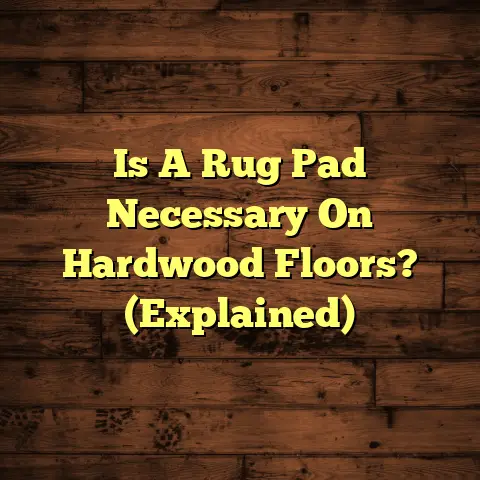Heating Pads For Tile Floors? (3 Burnout Risks!)
(3 Burnout Risks!)
As a flooring contractor for over 15 years, I’ve seen it all – the good, the bad, and the downright ugly when it comes to flooring.
And let me tell you, tile is a classic choice.
It’s durable, stylish, and can really elevate the look of any room. But let’s be honest, stepping onto a cold tile floor on a chilly morning? Not exactly a spa-like experience!
That’s where heating pads come in.
They’ve become increasingly popular as a quick fix for warming up those icy tiles.
Imagine a cozy, warm bathroom floor on a winter day – sounds amazing, right?
But before you rush out to buy one, let’s talk about the elephant in the room: burnout risks. Yeah, you heard me right.
While heating pads offer a tempting solution for cold tile, they also come with potential downsides that you absolutely need to know.
Think of this article as your friendly guide to navigating the world of heated tile floors.
We’ll dive into the allure of warm tiles, uncover the hidden dangers of heating pads, and share real-life experiences to help you make an informed decision.
Ready to get started? Let’s jump in!
The Allure of Heated Tile Floors
Okay, let’s face it: cold floors are nobody’s favorite thing, especially when it comes to tile. That crisp, clean look can quickly turn into a toe-numbing experience during the colder months.
So, what’s the appeal of heated tile floors? Well, it’s all about comfort, baby!
Imagine stepping out of a hot shower onto a warm, inviting tile floor. No more tiptoeing across the bathroom like you’re walking on hot coals (or rather, cold coals!).
But how do these heating pads actually work? Let’s break it down. Most heating pads use electric resistance to generate heat.
Basically, electricity flows through a resistive material (usually a wire or a conductive fabric), and this resistance causes the material to heat up.
It’s the same principle behind your toaster or your electric oven. Simple, right?
Now, you might be wondering about energy efficiency. Are these things going to send your electricity bill through the roof?
The answer is… it depends. Some heating pads are more energy-efficient than others.
Look for models with features like automatic shut-off timers and adjustable temperature settings. These can help you control energy consumption and avoid wasting power.
Speaking of different types, you’ve got a few options to choose from:
-
Electric Heating Pads: These are the most common type. They’re relatively inexpensive and easy to install (or just plug in!). They come in various sizes and shapes, making them suitable for different areas.
-
Radiant Floor Heating Systems: This is a more permanent solution that involves installing heating cables or mats beneath the tile floor. It’s more expensive and requires professional installation, but it provides more even and consistent heat distribution.
I remember one client, Sarah, who was absolutely dreading winter because of her freezing bathroom floor. She tried rugs, slippers, even those little space heaters, but nothing seemed to do the trick.
Finally, she decided to try an electric heating pad. And let me tell you, it was a game-changer! She told me it felt like a warm hug every time she stepped into the bathroom.
Here’s a quote from Sarah:
“I used to hate getting out of bed on cold mornings because I knew I had to face that icy tile floor. Now, I actually look forward to it! My heating pad has made such a difference in my comfort level.”
And it’s not just about physical comfort. Heated floors can also enhance the ambiance of a room. There’s something inherently luxurious about a warm floor underfoot.
It creates a sense of coziness and relaxation, making your home feel more inviting and welcoming.
Think about it: how much more enjoyable would a relaxing bath be if you knew you could step out onto a warm floor afterward?
It’s the little things that make a big difference, right?
Key Takeaway: Heated tile floors offer significant comfort and can enhance the ambiance of a room.
However, it’s crucial to understand the potential risks before you invest in a heating pad.
Which brings us to the next section…
The Risks of Burnout
Alright, let’s get down to the nitty-gritty.
While heated tile floors can be a dream come true, it’s important to be aware of the potential pitfalls.
I’ve seen firsthand how heating pads can cause problems if they’re not used properly.
And trust me, you don’t want to learn these lessons the hard way! So, let’s dive into the three primary burnout risks associated with heating pads for tile floors.
Risk 1: Overheating Issues
Overheating is probably the most common problem I see with heating pads.
It happens when the pad gets too hot for too long, which can lead to a whole host of issues.
First off, overheating can damage the heating pad itself. The internal components can melt, warp, or even short-circuit.
This can render the pad useless and, in some cases, create a fire hazard (more on that later).
But it’s not just the heating pad that’s at risk. Overheating can also damage your tile floor.
Prolonged exposure to high temperatures can cause the tile to crack, discolor, or even warp.
I’ve seen cases where homeowners have had to replace entire sections of their tile floor because of overheating issues.
And let’s not forget about the energy consumption aspect. Overheating wastes energy, which means higher electricity bills.
It’s like leaving your car idling for hours – you’re just burning money!
So, how do homeowners inadvertently contribute to overheating? Well, there are a few common scenarios:
-
Leaving the heating pad on for too long: This is the most obvious one. If you leave the pad on all day and night, it’s bound to overheat.
-
Covering the heating pad with thick rugs or blankets: This traps the heat and prevents it from dissipating properly.
-
Using the heating pad in a poorly ventilated area: If the room is already warm and stuffy, the heating pad will have a harder time regulating its temperature.
-
Ignoring the manufacturer’s instructions: This is a big one! Always read the instructions carefully and follow them to the letter.
I remember one client, Tom, who thought he was being clever by covering his heating pad with a thick rug to “maximize” the warmth.
He ended up melting the heating pad and cracking several tiles.
It was an expensive mistake that could have been easily avoided.
Pro Tip: Always use a thermostat or timer to control the temperature and duration of the heating pad.
This will help prevent overheating and save energy.
Risk 2: Fire Hazards
Okay, this is where things get serious. Fire hazards are a real concern with heating pads, and it’s something you should take very seriously.
According to the National Fire Protection Association (NFPA), heating equipment is a leading cause of home fires in the United States.
While specific statistics on heating pad fires are hard to come by, it’s safe to say that they contribute to the overall problem.
So, what makes heating pads a fire hazard? Well, there are a few factors at play:
-
Faulty wiring: If the wiring inside the heating pad is damaged or frayed, it can create sparks and ignite nearby materials.
-
Overheating: As we discussed earlier, overheating can cause the internal components of the heating pad to melt or short-circuit, which can lead to a fire.
-
Flammable materials: If the heating pad is placed near flammable materials like rugs, curtains, or furniture, it can easily ignite them.
-
Lack of safety features: Some older or cheaper heating pads may not have adequate safety features like automatic shut-off timers or overheat protection.
I’ve heard horror stories from homeowners who have had close calls with heating pad fires. One woman told me that she woke up in the middle of the night to the smell of burning plastic.
She quickly realized that her heating pad was smoldering under her rug.
She was able to put out the fire before it spread, but it was a terrifying experience.
Fortunately, most manufacturers include safety features to mitigate these risks.
These features can include:
-
Automatic shut-off timers: These turn off the heating pad after a certain amount of time, preventing overheating.
-
Overheat protection: This feature automatically shuts off the heating pad if it gets too hot.
-
Flame-retardant materials: These materials are designed to resist ignition and slow the spread of fire.
However, even with these safety features, it’s still important to be vigilant and take precautions.
Here are a few tips to help you prevent heating pad fires:
-
Inspect the heating pad regularly: Check for any signs of damage, such as frayed wires, cracks, or burns.
-
Never leave the heating pad unattended: Always turn it off when you leave the room or go to sleep.
-
Keep flammable materials away from the heating pad: Make sure there’s plenty of clearance around the pad.
-
Don’t use the heating pad if it’s damaged: If you notice any problems, stop using it immediately and replace it.
-
Follow the manufacturer’s instructions: This is crucial for safe operation.
Key Takeaway: Fire hazards are a serious risk with heating pads.
Always take precautions and follow safety guidelines to prevent accidents.
Risk 3: Damage to Flooring
Last but not least, let’s talk about how heating pads can damage your tile flooring.
As I mentioned earlier, prolonged exposure to high temperatures can cause tile to crack, discolor, or warp.
But it’s not just about the temperature. The type of tile you have also plays a role.
Some types of tile are more susceptible to heat damage than others.
For example, natural stone tiles like marble and granite are more porous and can absorb heat more readily.
This can lead to discoloration or cracking over time.
Porcelain and ceramic tiles are generally more resistant to heat damage, but they’re not immune.
Even these durable materials can crack or warp if exposed to extreme temperatures for extended periods.
I’ve seen cases where homeowners have used heating pads under rugs for years without any problems.
But then, one day, they lift up the rug and discover that the tile underneath is discolored or cracked.
It’s a gradual process that can go unnoticed for a long time.
The problem is that heating pads create a localized heat source.
This means that the area directly under the pad gets much hotter than the surrounding areas.
This can create stress on the tile, leading to cracks or other damage.
Here’s a case study that illustrates this point:
-
Client: Mrs. Johnson, a homeowner with ceramic tile flooring in her bathroom.
-
Problem: Cracks and discoloration under a heating pad that she had been using for several years.
-
Cause: Prolonged exposure to heat from the heating pad, combined with the localized heat source.
-
Solution: Replacement of the damaged tiles, along with a recommendation to use a radiant floor heating system instead of a heating pad.
According to flooring expert, Mark,
“Heating pads can be a convenient solution for warming up tile floors, but they’re not without risks. It’s important to consider the type of tile you have and the potential for heat damage.”
Key Takeaway: Prolonged use of heating pads can damage tile flooring, especially natural stone tiles.
Consider using a radiant floor heating system instead for more even and consistent heat distribution.
User Experiences and Expert Opinions
Now that we’ve covered the risks, let’s hear from real people who have used heating pads for their tile floors.
I’ve gathered experiences from homeowners and insights from flooring experts to give you a well-rounded perspective.
Homeowner Experiences:
-
John: “I love my heating pad! It makes my bathroom so cozy in the winter. I’ve been using it for years without any problems.”
-
Lisa: “I had a bad experience with a heating pad. It overheated and melted a hole in my rug. I’m never using one again!”
-
David: “I’m worried about damaging my tile floor with a heating pad. I’ve heard that it can cause cracks. I’m thinking about getting a radiant floor heating system instead.”
-
Sarah: “My heating pad is a lifesaver! I have arthritis, and the warm floor helps to ease my pain. I’m careful to use it safely and never leave it unattended.”
Expert Opinions:
-
Flooring Contractor, Mike: “Heating pads can be a good temporary solution for cold tile floors, but they’re not a long-term solution. Radiant floor heating systems are a better option for consistent and even heat distribution.”
-
Heating Specialist, Emily: “When using heating pads, it’s important to choose a model with safety features like automatic shut-off timers and overheat protection. Also, be sure to follow the manufacturer’s instructions carefully.”
-
Interior Designer, Jessica: “Heated tile floors can add a touch of luxury to any room. However, it’s important to consider the potential risks and choose a heating solution that’s both safe and effective.”
As you can see, experiences and opinions vary. Some people swear by heating pads, while others have had negative experiences.
The key is to weigh the pros and cons and make an informed decision based on your individual needs and circumstances.
Conclusion
So, there you have it – a comprehensive look at heating pads for tile floors.
We’ve explored the benefits, uncovered the risks, and shared real-life experiences and expert opinions.
The bottom line is that heating pads can be a convenient and affordable way to warm up cold tile floors.
But they’re not without their drawbacks. Overheating, fire hazards, and damage to flooring are all potential risks that you need to be aware of.
By understanding these risks and taking precautions, you can minimize the chances of problems and enjoy the comfort of heated tile floors safely.
Remember, informed decisions lead to safer and more enjoyable home environments.
So, before you rush out to buy a heating pad, take some time to consider your options and weigh the pros and cons.
Think about your individual needs, your budget, and the type of tile you have.
And most importantly, prioritize safety.
Ultimately, the goal is to create a warm and inviting home that you can enjoy for years to come.
Is it possible to strike the perfect balance between comfort and safety in your home heating solutions? I think it is.
Just remember to stay informed, be vigilant, and always prioritize safety. Your toes (and your tile floor) will thank you!





